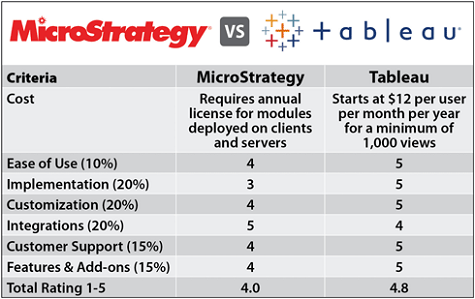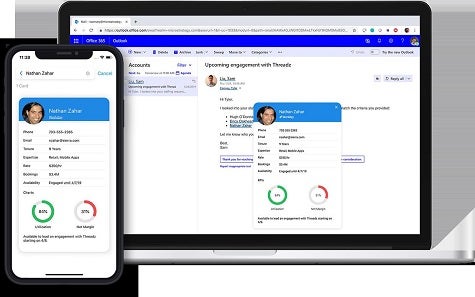In many ways, the contest between MicroStrategy versus Tableau is emblematic of the business intelligence wars that played out over the last two decades. MicroStrategy is one of the dominant providers of centralized data warehouses. Once upon a time, the only way business analysts could generate a report was to ask an IT department to run one for them against the data stored in a data warehouse. That process could take a week or more.
When Tableau arrived, it rapidly became an alternative platform for visualizing and analyzing data on a local server. Business analysts could not only self-service their own needs, they could also interrogate data stored in-memory at will.
Flash forward nearly two decades and now MicroStrategy provides a decentralized analytics application to compete head-to-head with Tableau alongside a centralized data warehouse. At the same time, Tableau has significantly expanded the amount of data it can analyze, both in-memory as well as stored externally on a hard drive.
MicroStrategy is clearly playing catch-up in terms of overall market share. However, the gap between Tableau and MicroStrategy in terms of analytics capabilities in the last few years has narrowed considerably.
What are the Similarities & Differences between MicroStrategy and Tableau?
In terms of the most widely employed analytics functions, it’s arguable that both platforms are more than capable of meeting most requirements. There are some data modeling capabilities aimed at specific niche use cases that are only supported in one application versus another.
At the core of Tableau is a patented VizQL engine invoked via a graphical user interface (GUI) that Tableau continues to extend with support for new data types and dashboards with every release. As a result, Tableau has gained a large loyal following among analysts who value, for example, the ability to leverage a drag-and-drop visual interface to easily render charts and drop them into other applications such as Microsoft Office 365 or Salesforce customer relationship management (CRM) software. Tableau also provides a wide variety of pre-packaged visualizations that reduces the amount of effort analysts need to make when trying to identify what type of chart lends itself best to a specific data set.
MicroStrategy relies on an in-memory columnar data store to provide an interactive across large and complex datasets and models that can natively span modeled and unmodeled data residing in relational databases, data lakes based on Hadoop or data stored locally. As a result, MicroStrategy lends itself better toward real-time analytics, also known as transactional analytics. MicroStrategy is also recognized for being more of an enterprise-class platform in terms of scalability, simpler administration, data storage and the data preparation tools included.
MicroStrategy can also show some differentiation that comes from its ability to leverage a semantic graph to drive “HyperIntelligence.” That capability makes it simpler to dynamically invoke MicroStrategy analytics from within another application using a “HyperCard” metaphor that allows, for example, a word in a report to be linked to a diagram.
Another area where MicroStrategy holds a slight edge is in terms of natural language queries, but Tableau is not very far behind. MicroStrategy, however, is relying on third-party natural language engines versus building its own.
The most subtle difference between the approaches of MicroStrategy and Tableau can be traced to their respective focus on the needs of the analysts who create reports versus those who consume them. Tableau provides a more intuitive experience for the analyst, while MicroStrategy has been focusing a little more time and effort on the needs of the end users who consume those reports. MicroStrategy has been leveraging its focus on Apple iPads and Apple iPhone devices to improve the overall mobile user experience. However, MicroStrategy appears to still have some work to do in terms of making it possible to create infographics.
Cost
The SaaS option for Tableau starts at $12 per user per month on an annual basis for a single user to view data. There are, however, several additional modules to address, for example, mobile computing requirements or the prepping of data, that most enterprise organizations are going to need to license for some users.
Tableau provides customers with Creator, Explorer and Viewer. Prices are listed per user, per month, billed annually. The Creator plan includes full functionality of Tableau, and costs $70 per user, per month, regardless of whether the platform is deployed on-premise on in the cloud. The Explorer plan targets users who want self-service analytics without the data prepping and cleaning. It costs $35 per user, per month for on-premises deployment, and $42 per user, per month if deployed in the cloud.
Both Tableau and MicroStrategy provide organizations with the ability to host their analytics applications in a cloud platform they manage. MicroStrategy, however, sells its software under a more traditional, and more complex, licensing model. Organizations can deploy the company’s software anywhere; however, navigating all the costs of all the clients and server components will require a lot of time and effort. Over the course of a five-year license, MicroStrategy is committed to making sure licensing costs are competitive against rival offerings. Nevertheless, many organizations may be wary of the lack of transparency.
Because the pricing plans between MicroStrategy and Tableau are so different, organizations would be well advised to carefully consider their total costs per user once all the elements of the analytics application they require are determined.
Ease of Use
Tableau makes it simple to drill down into data without having to, for example, manually create calculations, design visualizations and format dashboards. Tableau is also investing in Ask Data natural language capabilities specifically designed for BI use cases. Overall, Tableau is accessible to almost any class of analyst in one form or another.
MicroStrategy, on the other hand, is gaining traction among organizations that want to make more so-called fact-based decisions that are supported by simple-to-understand visualizations that are easily distributed across the organization.
MicroStrategy in its most recent release also includes a range of natural language capabilities that would suggest it may be, for now at least, a little farther down the path to providing augmented analytics capabilities leveraging machine learning algorithms. It would, however, be far too early to call a winner in the race to AI.
MicroStrategy User Interface (Screenshot)
Tableau User Interface (Screenshot)
Implementation
Given its longer focus on departmental use cases, Tableau is easier for most departments to set up. In contrast, MicroStrategy is going to require some help from the IT department to take full advantage of its capabilities.
Tableau also offers Tableau Public, a free service that an end user can employ to visualize, for example, a single instance of a Microsoft Excel spreadsheet.
Customization
Tableau provides tools that enable experts to customize reports and dashboards. MicroStrategy provides tools that require developer expertise to customize the application environment. Those customizations, however, can be richer and deeper inside the application environment.
Integrations
Tableau provides 65 connectors that can be immediately deployed to access more than 40 data sources. MicroStrategy provides over 40 connectors with hundreds more available.
It’s worth noting, however, that MicroStrategy goes a step further in terms of natively integrating the connectors to its metadata engine. MicroStrategy is also making using of REST APIs to open that metadata engine via its semantic graph to other front-end tools. There are also JavaScript APIs and software development kits to support custom analytic application development.
Tableau, in contrast, makes available an Extensions API for its dashboards.
Customer Support
Tableau offers free support via website, knowledge bases and a large online community. Tableau also provides several tiers of paid support.
MicroStrategy provides support under the terms of its various classes of enterprise licenses.
Features & Add-ons
In terms of data visualization capabilities, both platforms provide a wide variety of options. Tableau provides access to a deeper set of visualizations and associated “story telling” tools. Tableau is also beta testing an Extension Gallery that makes it simpler to discover third-party add-on tools. Given its larger installed base, Tableau right now has attracted a larger pool of third-party developers to its platform.
See Other Popular Business Intelligence Comparisons
How to Choose the Best Business Intelligence Software to Fit Your Needs
Although Tableau has come a long way from its days when it was perceived to be mainly a departmental analytics application, there are still some shortcomings in terms of the suitability of the platform for being employed at scale within an enterprise.
Nevertheless, Tableau continues to gain momentum. The company saw a 15 percent gain to bring its revenue for the quarter to $282.5 million, while posting a GAAP operating loss of $93.2 million, which compares to a loss of $50.4 million in the same period a year ago. Despite those losses, however, organizations should also factor the number of analysts who might already know how to take full advantage of Tableau into their decision making.
In comparison, in its most recent first quarter, MicroStrategy generated revenues of $131.9 million, a 3 percent decrease year over year. Net income for the fourth quarter of 2018 was $3.3 million, compared to net loss of $25.5 million for the fourth quarter of 2017. The net loss in the fourth quarter of 2017 included an estimated one-time tax charge of $44 million resulting from the enactment of U.S. corporate tax reform legislation.
Both Tableau and MicroStrategy recently upgraded their core engines. In fact, MicroStrategy 10 was so different that it is not compatible with previous releases of the company’s software. Both companies are clearly maneuvering into position to compete fiercely to dominate the next generation of analytics.
Regardless of the platform chosen, the one thing organizations should keep in mind is that the cost of building those next-generation analytics applications that include, for example, augmented AI capabilities is only like to increase for the foreseeable future, so the financial wherewithal of an analytics software vendor matters now more than ever.





